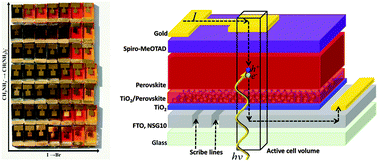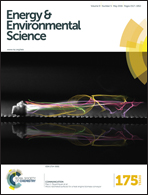Exploration of the compositional space for mixed lead halogen perovskites for high efficiency solar cells†
Abstract
Lead halide perovskites have attracted considerable interest as photoabsorbers in PV-applications over the last few years. The most studied perovskite material achieving high photovoltaic performance has been methyl ammonium lead iodide, CH3NH3PbI3. Recently the highest solar cell efficiencies have, however, been achieved with mixed perovskites where iodide and methyl ammonium partially have been replaced by bromide and formamidinium. In this work, the mixed perovskites were explored in a systematic way by manufacturing devices where both iodide and methyl ammonium were gradually replaced by bromide and formamidinium. The absorption and the emission behavior as well as the crystallographic properties were explored for the perovskites in this compositional space. The band gaps as well as the crystallographic structures were extracted. Small changes in the composition of the perovskite were found to have a large impact on the properties of the materials and the device performance. In the investigated compositional space, cell efficiencies, for example, vary from a few percent up to 20.7%. From the perspective of applications, exchanging iodide with bromide is especially interesting as it allows tuning of the band gap from 1.5 to 2.3 eV. This is highly beneficial for tandem applications, and an empirical expression for the band gap as a function of composition was determined. Exchanging a small amount of iodide with bromide is found to be highly beneficial, whereas a larger amount of bromide in the perovskite was found to cause intense sub band gap photoemission with detrimental results for the device performance. This could be caused by the formation of a small amount of an iodide rich phase with a lower band gap, even though such a phase was not observed in diffraction experiments. This shows that stabilizing the mixed perovskites will be an important task in order to get the bromide rich perovskites, which has a higher band gap, to reach the same high performance obtained with the best compositions.


 Please wait while we load your content...
Please wait while we load your content...